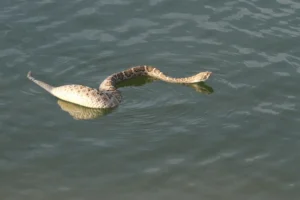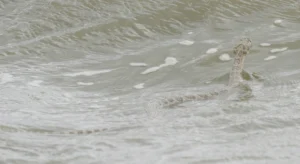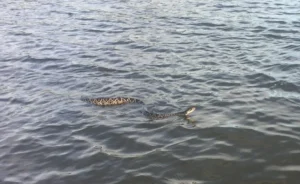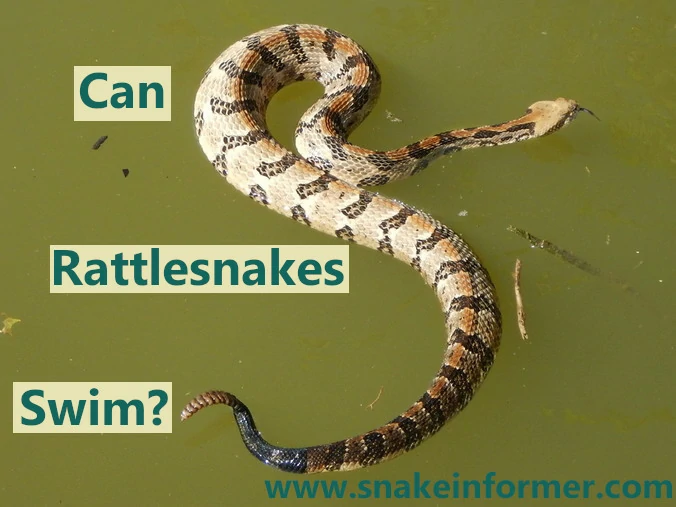When you think of rattlesnakes, you probably imagine them slithering across desert sands. However, these snakes live in a wide variety of habitats and are highly adaptable.
Rattlesnakes are very capable swimmers and can move through water with surprising agility. They swim by wriggling their bodies from side to side, in a winding motion, while keeping their heads above the water.
Some rattlesnakes live near rivers or lakes, and will often swim as they move around their environments.
Unlike many snakes, rattlesnakes typically do not eat fish or other aquatic prey. They dont swim to hunt prey.
Instead, they swim to move around different areas of their environment, or even to escape predators.
Rattlesnakes Are Very Strong Swimmers
Rattlesnakes are naturally buoyant and can instinctively swim when they get into the water.

They swim in a similar way to how they move on land; by winding their bodies in an ‘S’ shape, while they keep their heads above the water.
That said, rattlesnakes are mainly terrestrial and prefer to be on dry land rather than out in the water.
They do not have many of the adaptions that many semi-aquatic snakes have, and are not as comfortable in the water.
Why Do Rattlesnakes Swim?
Rattlesnakes have a very wide distribution and can be found in a variety of environments, from wetlands to forests, to dry regions.
For this reason, these snakes have adapted to effectively move through a wide variety of habitats.
Rattlesnakes can swim, move across sand, and even climb trees, with relative ease.
Here are a few things that rattlesnakes use their swimming ability for:
1. To Find Food
Rattlesnakes are opportunistic predators that eat birds, small reptiles, rodents, and other small animals such as rabbits.
If prey is more abundant across a pond, river, or stream, a rattlesnake may swim across to pursue it.
As earlier mentioned, rattlesnakes don’t eat fish or other aquatic prey. They won’t hunt in the water but may cross it to reach land with good feeding opportunities.
2. Moving Across Different Areas of Their Environment
Swimming is often necessary to move around, in an environment with lots of water bodies.
Rattlesnakes will regularly swim across small ponds to get to areas with better shelter, or better protection from the elements.

If a rattlesnake has to move from one point to another, it may swim.
3. Predator Avoidance
Rattlesnakes are preyed on by coyotes, hawks, eagles, and even other snakes such as Kingsnakes.
One of the main ways these snakes protect themselves from predators is to remain unseen.
When they spot a predator, rattlesnakes will typically remain motionless, and rely on their camouflage to blend into their environment. Their coloration makes them hard to see in grassy areas.
However, when they are spotted by a predator, rattlesnakes may attempt to escape.
A rattlesnake can quickly slither into a nearby pond or stream, and hide among vegetation, to escape predators on land.
4. Escaping Flood Waters
Sometimes, the areas rattlesnakes live in, experience flooding, and the snakes have to swim to higher ground seeking safety.
For example, rising waters may displace rattlesnakes hiding in underground burrows.
5. To Cool Down in Hot Weather
Like all reptiles, rattlesnakes are cold-blooded (ectothermic) animals.
This means they cannot internally regulate their body temperature. Instead, their body temperature changes with the temperature in their surroundings.
In other words, their environment is the main influence on their body temperature.
As the temperature changes at different times of day and night, rattlesnakes move around in their environment to regulate their body heat. This is known as “behavioral thermoregulation.”
While very rare, some rattlesnakes may enter the water to cool down on a particularly hot day. However, this is not common behavior.
Can Rattlesnakes Bite While Swimming?
Rattlesnakes have a venomous bite, however they mainly strike from a coiled position on the ground.
When swimming in the water, their bodies are stretched, so they will have a harder time striking.

However, that does not mean they can’t bite while in the water.
If a rattlesnake feels threatened, it may attempt to bite – whether on land or in the water.
It’s a good idea not to approach or handle any rattlesnake you see in the water. Leave the snake alone, and it will be totally harmless.
Can Rattlesnakes Breathe Underwater?
Snakes in general can not breathe underwater, and that includes rattlesnakes.
Rattlesnakes often only swim on top of the water and do not dive or submerge in the water.
Many rattlesnakes also prefer to swim in shallow water, where they can easily avoid submerging.
How Long Can Rattlesnakes Stay Underwater?
While rattlesnakes typically swim on top of the water, they are capable of submerging if they need to (eg, to escape a predator).
When they go underwater, they hold their breath until they return to the surface.
How long a rattlesnake can stay underwater after is mainly dependent on
- The temperature
- How active the snake is
1. Temperature
As mentioned earlier, rattlesnakes are cold-blooded animals.
Being cold-blooded means rattlesnakes will have a varied rate of metabolism, depending on the water temperature.
Warmer water temperatures increase metabolic rates. This means rattlesnakes have to resurface more often to get oxygen.
On the opposite end, cooler water allows rattlesnakes to conserve oxygen. This extends the time they can hold their breath.
2. How Active the Snake Is
Activity affects how much oxygen the body needs.
Think about it. When you are running or jogging, you breathe in much quicker breaths than when you are lying on the couch.
For snakes, this is also true. Their oxygen demands will be influenced by their activity levels.
A rattlesnake that is resting on the bottom of shallow water may be able to stay submerged for a significant amount of time.
On the other hand, an individual who is escaping a predator– may only be able to stay underwater for a very short period before needing to surface to replenish its oxygen supply.
Can Rattlesnakes Drown?
Like all snakes, rattlesnakes are air-breathing reptiles, and if their lungs fill with water, they can drown.
For example, if a rattlesnake is entangled in a fishing net, the snake may drown if it is unable to free itself.
Prolonged stays underwater can lead to suffocation and drowning for any snake.
Conclusion
Rattlesnakes live in a wide variety of habitats from grasslands to woodlands, to deserts.
Some rattlesnakes find themselves near rivers, streams, lakes, ponds, or wetlands.
These snakes frequently venture into the water and are excellent swimmers.
They don’t hunt in the water but will go into the water to reach land, where they can hunt for rodents, birds, lizards, and other prey.
Apart from finding, these snakes also rely on their swimming ability to move between different parts of their habitat and to escape land predators.
Hi, my name is Ezra Mushala, i have been interested animals all my life. I am the main author and editor here at snakeinformer.com.

